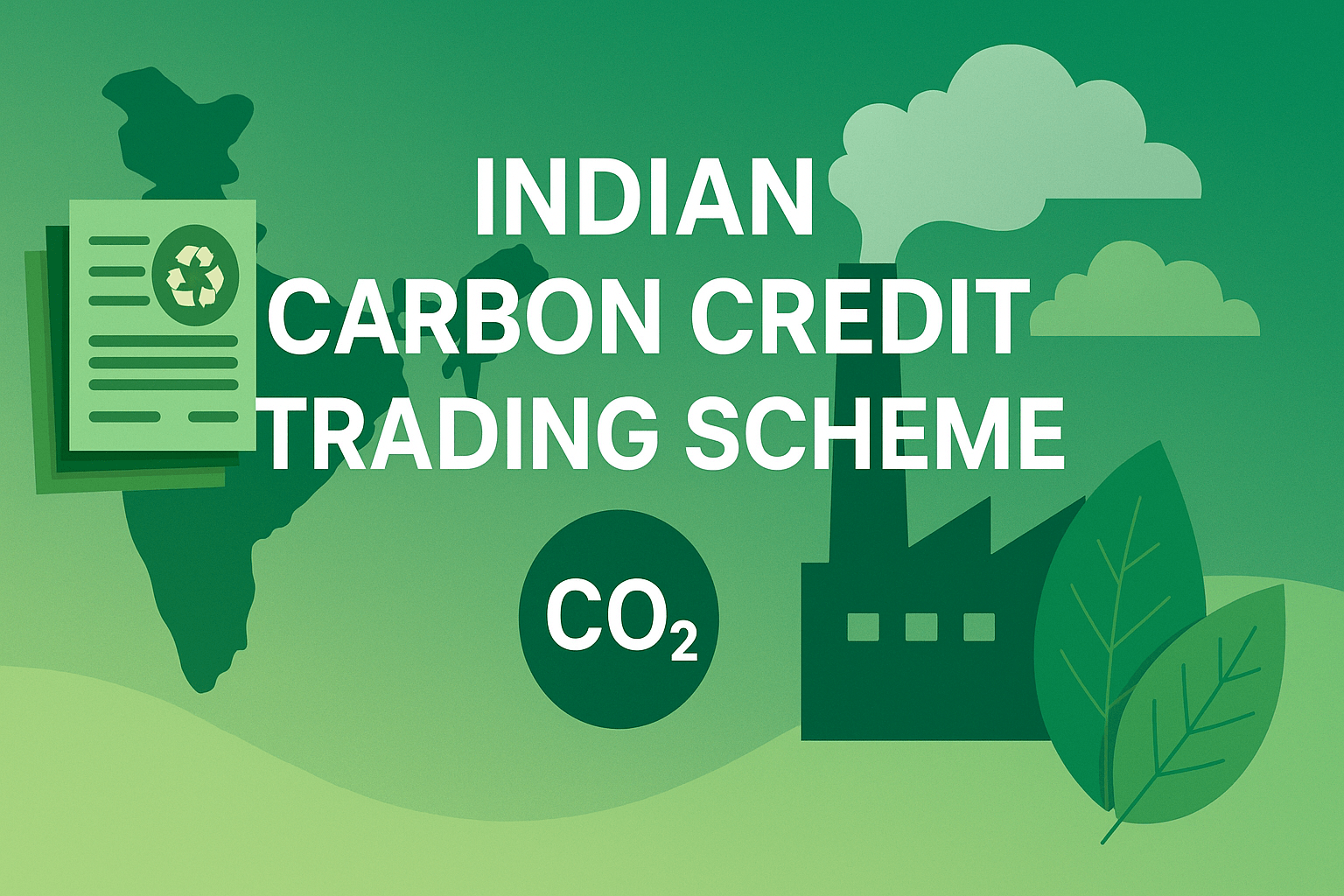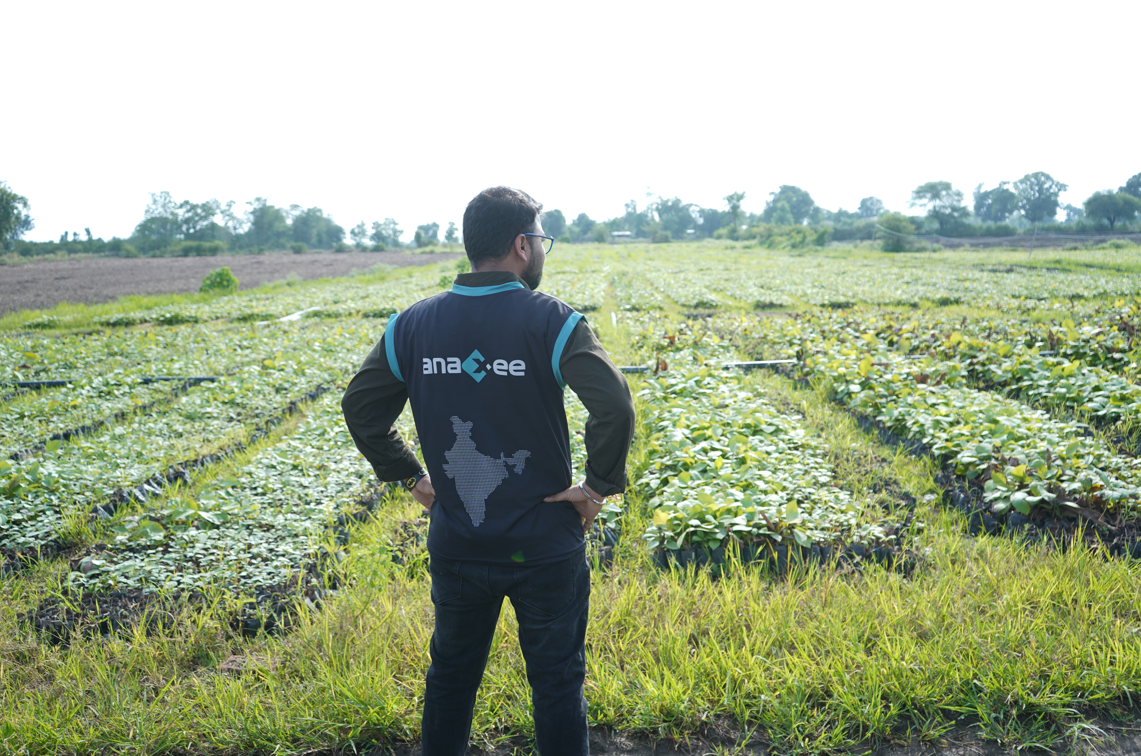BLOG

India’s Carbon Credit Trading System (CCTS) Explained- How to Navigate the New Indian Carbon Market in 2025
1. Why Another Carbon Market- and Why Now?
India’s greenhouse-gas (GHG) emissions still trail those of China and the US on a per-capita basis, but its overall share is climbing fast. To square rapid industrial growth with its updated Nationally Determined Contribution—45 % emissions-intensity cut by 2030 and net-zero by 2070—New Delhi is rolling out a two-tier carbon market: a compliance mechanism for big emitters and a voluntary offset window for everyone else. That umbrella framework is called the Carbon Credit Trading System (CCTS).
Global politics add urgency. From 2026 the EU’s Carbon Border Adjustment Mechanism (CBAM) will slap tariffs on carbon-heavy imports; Indian exporters risk losing price advantage unless they can prove decarbonization. The CCTS provides a domestic price signal and an internationally credible emissions ledger.
2. The Legislative Backbone: 2022–2025 in Fast-Forward
| Date | Milestone | What it Means |
| Aug 2022 | Energy Conservation Act (Amendment) Bill passed | Legal authority for the GoI to issue and trade carbon-credit certificates (CCCs). |
| Jun 2023 | Carbon Credit Trading Scheme Notification | Sets up National Steering Committee for the Indian Carbon Market (NSCICM), defines institutional roles. |
| Jul 2024 | Detailed Procedure for Compliance Mechanism | Lays out MRV rules, registry design, banking limits, penalties. |
| Mar 2025 | MoP approves 8 voluntary methodologies (renewables, green hydrogen, mangroves, etc.) | Opens non-industrial sectors to earn tradable CCCs. |
| Jun 2025 | Draft emissions-intensity targets released | First time individual plants see proposed 2025-27 benchmarks. |
| Jun 2025 | BEE draft target-setting notification | Formal consultation on baselines and trajectories. |
3. Who Regulates What?
– Ministry of Power (MoP) – overall custodian of the Indian Carbon Market (ICM).
– Ministry of Environment, Forest & Climate Change (MoEFCC) – notifies legally binding intensity targets under the Environment Protection Act.
– Bureau of Energy Efficiency (BEE) – administrator: sector analysis, target calculation, issuance of Carbon Credit Certificates (CCCs).
– Grid Controller of India (GCI) – runs the registry.
– Central Electricity Regulatory Commission (CERC) – licenses power exchanges and sets trading rules. Draft CERC regulations allow CCC trading on any recognised exchange; OTC deals remain barred for now.
4. Scope and Coverage: Phase 1 (FY 2026)
– Nine PAT-sectors migrate first: aluminium, chlor-alkali, cement, fertiliser, iron & steel, pulp & paper, petro-chemicals, petroleum refining, textiles.
– ~800 facilities above PAT thresholds expected.
– GHGs: CO₂ and PFCs initially.
– Metric: sector-specific emissions-intensity (t CO₂e / unit of product).
– Compliance cycle: annual reporting, three-year rolling targets.
Voluntary Window
Parallel rules enable non-covered sectors—agriculture, forestry, resi-buildings, green hydrogen—to register projects and generate CCCs. Renewable-energy credits formerly traded in the REC market can migrate once methodologies are approved.
5. How the Compliance Mechanism Works
-
Baseline & Target Setting
BEE calculates each sector’s trajectory factoring technology potential, historic energy data and 2023-24 emissions. Draft benchmarks for 2025-27 are open for comment until late July 2025. -
Monitoring & Verification (MRV)
Gate-to-gate coverage of Scope 1 & 2 emissions; some Scope 3 (intermediate product trade) included. Entities must submit a verified GHG report within 4 months of FY close. Non-compliance triggers financial penalties under the Energy Conservation Act. -
Issuance of CCCs
Over-achievers earn one CCC per tonne of CO₂e saved vs. target. Under-performers must buy and surrender CCCs. -
Trading
Trades occur on power exchanges (IEX, HPOWERT, PXIL) under CERC oversight. No derivatives or short selling in phase 1; unlimited banking but no borrowing.
6. Timeline to First Trade- Reality Check
While initial MoP roadmaps imagined first trades in April 2025, institutional delays mean mid-2026 is more realistic, according to recent statements by the Power Minister. Petroleum-Economist analysis even warns of slippage into late 2026 if registry testing drags.
7. PAT to CCTS: What Changes for Industry?
| Issue | PAT (2012-24) | CCTS (2025-on) |
| Instrument | ESCerts (energy savings) | CCCs (GHG reductions) |
| Coverage | 13 sectors | Initially 9 sectors (expandable) |
| Metric | Energy/mass | GHG tCO₂e/unit |
| Trading venue | Power exchanges | Same, but stricter MRV & penalties |
| Banking | Limited across cycles | Unlimited within compliance mechanism |
PAT experience gives firms a head-start on data systems, but emissions accounting demands fuel-specific NCVs, process-emissions factors and third-party verification—a leap in complexity.
8. The Voluntary Crediting Piece: New Money for New Sectors
On 28 March 2025 the MoP green-lit eight methodologies—including mangrove afforestation and green hydrogen—under a domestic offset mechanism. Expect full guidelines by Q4 2025 and trading once registry APIs integrate project issuances. That opens doors for:
-
Agro-forestry & Soil Carbon projects—big rural job creators.
-
Distributed clean-cooking (ICS) roll-outs.
-
Digital MRV providers (remote sensing, blockchain).
9. What This Means for Corporates
Compliance Entities
-
Model your intensity gap now using 2023-24 GHG data.
-
Identify least-cost abatement (heat-recovery, fuel switch, electrification).
-
Set up registry & exchange accounts early; auction windows may be thin.
-
Budget for carbon price volatility; analysts expect ₹600-₹1 200 /t ($7–14) in phase 1.
Non-Covered Players
-
Scout eligible project types (RE, hydrogen, mangroves, cookstoves).
-
Register early to benefit from first-mover credit scarcity.
-
Bundle small projects—volume matters for liquidity.
10. Challenges Nobody Should Ignore
| Risk | Details | Mitigation |
| MRV capacity gap | India has <250 accredited verifiers; ~800 plants need annual audits. | Outsource to global auditors; build domestic capacity quickly. |
| Price discovery | Single-commodity exchanges could see thin volumes, wide bid-ask spreads. | CERC exploring market-maker role, but clarity pending. |
| Overlaps with REC/RPO, HPO | Firms could face multiple, sometimes conflicting, certificate obligations. | Government promised harmonisation, but rules still in draft. |
| CBAM alignment | EU may not recognise intensity-based credits. | Seek bilateral equivalence or use CCTS as step toward absolute caps post-2030. |
| Data fraud | High stakes may tempt mis-reporting. | Blockchain registry pilots, AI-based anomaly detection (where firms like Anaxee can add value). |
11. Strategic Playbook for 2025–27
-
Map Exposure: Quantify both compliance burden and offset opportunity.
-
Invest in Data Infrastructure: Digital MRV will be a licence to operate.
-
Engage Policy Consultation: Target-setting drafts are live; lobby for realistic baselines.
-
Train Teams: Carbon accounting skills are scarce—build them in-house or partner.
-
Communicate: Investors increasingly price transition plans—use the CCTS narrative to showcase readiness.
12. Looking Ahead
India’s CCTS is not a quick copy-paste of the EU ETS; it’s an intensity-based hybrid tuned to India’s growth trajectory. The upside? Flexibility and political feasibility. The downside? Complexity and a risk of weak price signals if targets are soft. 2025-26 will be the shakedown period. Early movers—either reducing emissions or minting high-integrity credits—stand to lock in low-cost advantages before the scheme tightens post-2030.
For companies that treat carbon management as a side-desk issue, CBAM and domestic penalties will be an expensive wake-up call. For those who treat CCTS as a strategic lever, it’s a chance to turn carbon compliance into competitive edge—and, with the right partners, an entirely new revenue stream.
Planning or Executing a Carbon Project? Need help with consultation or implementation? Connect with Anaxee at sales@anaxee-wp-aug25-wordpress.dock.anaxee.com
References
ICAP ETS Database, “Indian Carbon Credit Trading Scheme” (July 2024 update) icapcarbonaction.com
Hindustan Times, “Govt notifies draft carbon rules for industries” (1 July 2025) hindustantimes.com
Press Information Bureau, “Carbon Pricing in India: Market Mechanisms for Climate Leadership” (23 June 2025) pib.gov.in
LinkedIn Article, A. Sheikh, “India’s CCTS: Policy in Motion” (26 Jun 2025) linkedin.com
SolarQuarter, “India Proposes New Emission Intensity Targets Under CCTS 2025” (26 Jun 2025) solarquarter.com
Economic Times Energy, “India to launch carbon market by 2026” (22 Feb 2025) energy.economictimes.indiatimes.com
CERC draft regulations summary, Mercom India (Nov 2024) mercomindia.com



